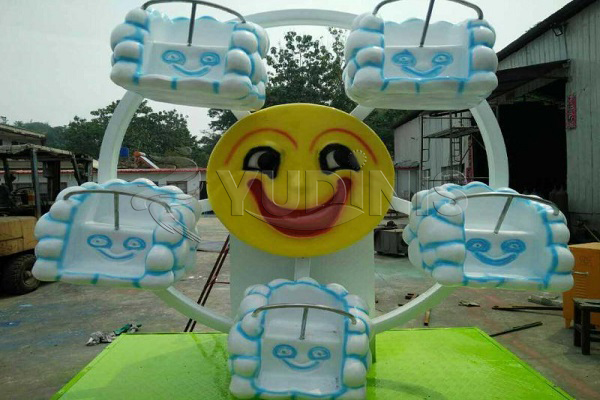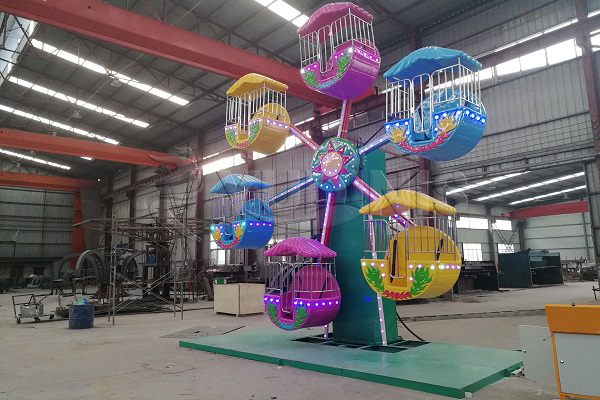Adding a small Ferris wheel for sale to your venue can significantly enhance its appeal, creating a family-friendly and visually striking attraction. Whether you’re outfitting an amusement park, festival, or shopping center, choosing the right Ferris wheel requires careful consideration of various factors. Here’s a guide to help you make the best decision for your space and audience.
1. Size and Space Considerations
Measure Available Space: Start by determining the amount of space you have for the Ferris wheel, including room for the base, safety zones, and access paths. Mini Ferris wheels kids ride come in various sizes, so be sure to select one that fits comfortably without overcrowding other attractions.
Height Limitations: Consider any height restrictions at your venue, whether due to building structures, trees, or local zoning regulations. Smaller Ferris wheels typically range from 10 to 20 meters in height, making them ideal for venues with limited vertical space.

2. Capacity and Ride Experience
Passenger Capacity: The capacity of a small Ferris wheel will influence how many riders can enjoy the attraction at once. Consider your expected visitor flow and choose a model that offers enough cabins or seats to minimize wait times. Small Ferris wheels typically accommodate 20-40 passengers per ride.
Ride Experience: Think about the type of experience you want to provide. A slower, gentle ride might appeal to families with young children, while a slightly faster ride could attract older children and teens. Evaluate ride speed, duration, and overall experience to ensure it aligns with your target audience.
3. Design and Theming
Aesthetic Appeal: The design of the small Ferris wheel amusement ride should complement the theme or style of your venue. Look for customizable options, such as color schemes, cabin designs, and lighting effects that can match your venue’s branding or festive themes.
Theming Options: If your venue has a specific theme, consider a Ferris wheel that can be customized accordingly. For example, a vintage-style Ferris wheel might suit a retro amusement park, while a sleek, modern design could fit a contemporary shopping mall or entertainment center.
4. Durability and Materials
Quality of Materials: Choose a Ferris wheel made from durable materials, such as stainless steel or high-quality aluminum, which can withstand weather elements if placed outdoors. Ensure that the cabins and other components are designed for long-lasting use, even in high-traffic environments.
Weather Resistance: If your Ferris wheel will be outdoors, consider how well it will hold up against rain, wind, and sun exposure. Look for UV-resistant paint and materials that are corrosion-resistant for a longer lifespan.
5. Safety Features
Safety Standards Compliance: Always ensure that the Ferris wheel meets international safety standards, such as ISO, ASTM, or EN certifications. This guarantees the ride’s structural integrity and passenger safety.
Advanced Safety Features: Look for additional safety features like automatic restraint systems, emergency stop mechanisms, and backup power in case of outages. These will enhance the safety and reliability of the ride, providing peace of mind for both you and your visitors.
6. Operational Costs and Maintenance
Energy Efficiency: Consider the operational costs of the theme park small ferris wheel ride, including energy consumption. Some models are designed to be more energy-efficient, which can help reduce long-term operating expenses.
Ease of Maintenance: Choose a Ferris wheel that offers easy maintenance. Look for models that come with a warranty, support services, and accessible replacement parts. Regular maintenance is essential for keeping the ride safe and operational, so factor this into your decision.

7. Budget and Return on Investment
Initial Investment: Establish your budget and explore models within that range. Small Ferris wheels vary in price depending on their size, materials, and custom features. A well-designed Ferris wheel can be a significant investment, so make sure it fits your financial plan.
Revenue Potential: Assess the potential revenue that the Ferris wheel can generate. Consider ticket pricing, ride frequency, and visitor volume. A small Ferris wheel can serve as a steady source of income, especially if it becomes a signature attraction.
8. Installation and Transportation
Installation Requirements: Ensure you understand the installation process, including the time required, necessary equipment, and technical support. Some models may require special foundations or anchoring, so be prepared for any additional installation costs. If you have need, you can contact professional small Ferris wheel manufacturer.
Portability: If you need a Ferris wheel for a temporary event or multiple locations, look for portable models that can be easily dismantled and transported. Portable small Ferris wheels are ideal for fairs, festivals, or events that move from place to place.
9. Customization Options
Branding and Sponsorship: Customizing your Ferris wheel with your venue’s branding, logos, or sponsorship opportunities can increase its appeal and provide an additional revenue stream. Many manufacturers offer design options that allow you to incorporate your venue’s identity into the ride.
Conclusion
Choosing the right small Ferris wheel for your venue involves a balance between size, capacity, design, safety, and cost. By considering these factors, you can select a Ferris wheel that not only fits your venue but also enhances the visitor experience, driving more traffic and providing a lasting source of revenue. Make sure to work closely with reputable manufacturers to find the best fit for your specific needs and budget. Know more information, click here: https://www.outdoorparkrides.com/small-ferris-wheel-for-sale/
Leave a Reply